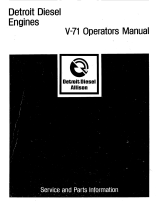10
8. Pre-run Inspection Procedures
Correct any problems discovered before operation.
Pre-startup inspection requirements
Perform a thorough inspection of the fuel powered components:
•Front and rear guards for damage, looseness.
•Shroud outer surface for nicks, cracks.
•Shroud inner surface for nicks, cracks, cleanliness. Verify all mounting hardware is of proper tightness.
•Propeller blades, front, back, leading and trailing edges for chips or cracks. Verify that blades are clean,
with no unusual wear or damage.
•Verify propeller tips-to-shroud clearance.
•Propeller drive belt for cracks, splits, fraying, de-lamination or tooth damage. Replace belt if any teeth
are missing or damaged. Proper tension. With a 2Kg load belt should deflect 6 – 14 mm when engine is
cold. Belt tension will change during operation.
•Exhaust system, all fasteners secure and in good condition. Check system for cracks.
•Check engine oil level. Visually inspect dipstick for oil quality, burnt odor, metal particles, excessive
moisture.
•Inspect engine for signs of oil or coolant leakage.
•Inspect coolant radiator for debris or damage.
•Engine coolant reservoir at proper level. Coolant hoses in good condition, no cracks, splits or leakage.
•Check that all electrical wires and connections are secure. Inspect all wires for insulation damage.
•Verify spark plug wires are secure.
•Check air filter element for damage, excessive dirt accumulation.
•Inspect fuel supply lines for cracks, splits or deterioration.
•Verify that a full supply of fuel is in fuel tank. Do not overfill. Proper starting fuel level is a minimum of
20mm below filler neck. Do not re-fuel while engine is running. Allow engine to cool before re-fueling.
•Battery charge condition, terminal connections.
•Check engine control / monitoring panel. All gauges in proper working condition. All markings and
labels in good condition.
Perform a thorough inspection of the hydraulic lift table and components:
Inspections are essential for proper operation and safety. Unit should be in the lowered position and the power
should be turned off and “locked out”. Follow your standard electrical lock out tag procedure.
•Check oil level in the lift, add as necessary.
•Perform a general inspection of all mechanical fasteners.
•Inspect all metal component assemblies for structural and weld integrity.
•Check hydraulic lines for damage or leakage.
•Check electrical wiring for damage or deterioration.
•Inspect all pivot points. Bearings without grease points are permanently lubricated and require no
servicing. Bearing or hinge points with grease points provided should be serviced.
•Clean area in and around lift so it is free of foreign objects or debris.
•Cycle hydraulic lift table through all motions prior to engine startup to purge air from cylinders.
























